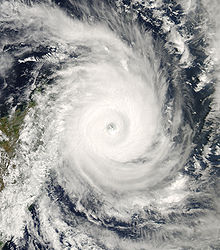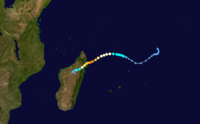- Cyclone Indlala
-
Intense Tropical Cyclone Indlala Intense tropical cyclone (MFR) Category 4 cyclone (SSHS) 
Tropical Cyclone Indlala near peak strength Formed March 9, 2007 Dissipated March 15, 2007 Highest winds 10-minute sustained:
175 km/h (110 mph)
1-minute sustained:
220 km/h (140 mph)Lowest pressure 935 mbar (hPa; 27.61 inHg) Fatalities 150 direct, 126 missing Damage $240 million (2007 USD) Areas affected Madagascar Part of the 2006-07 South-West Indian Ocean cyclone season Tropical Cyclone Indlala was an Intense Tropical Cyclone that caused severe damage in Madagascar in 2007. The 12th tropical system, 9th named storm, and 5th intense tropical cyclone of the 2006-07 South-West Indian Ocean cyclone season, Indlala developed on March 3, 2007 as a tropical depression. It moved westward and was upgraded to Tropical Depression 12 on March 6. In an area of favorable environment for tropical cyclone formation, it tracked westward, steadily intensifying. It was upgraded to Moderate Tropical Storm Indlala on March 12. It continued to intensify and became a Severe Tropical Storm the next day. It then became a Tropical cyclone that same day as it moved westward and was upgraded to Intense Tropical Cyclone Indlala as it reached its peak intensity of 155 mph shortly before making landfall in the northeastern section of Madagascar.
The storm resulted in 150 fatalities in Madagascar. 126 people were also reported missing,[1] and 125,000 people were directly affected by the storm. Severe flooding, high wind and storm surge pounded the coastal areas, while inland, flooding from heavy rainfall caused extreme damage. In Maroanstetra, one of the hardest hit regions, the entire region was flooded, and 90 percent of the surrounding villages were flooded. Ten percent of the concrete houses and 35 percent of traditional wood houses were destroyed there. Damage totaled to US$240 million.[2]
Contents
Meteorological history
Indlala's origins were from a large monsoonal low pressure system on March 3, 2007, near 14.9°N, 61.8°N.[3] The low pressure system began to intensify, with deep convection developing around the center of circulation.[4] The system began to track westward with an increasingly better-defined center. Lower-level inflow was favorable for tropical cyclone development, but upper-level divergence was weak.[5] The system was then upgraded to Tropical Depression 12, with the increased convection and a well-defined center. However, within 12 hours, the storm entered an area of high wind shear which led to the northeastern section of the storm's circulation to be exposed.[6] The system reorganized and was once again in a steady intensification period.[7] On March 12, the system was upgraded to Moderate Tropical Storm Indlala.[8]
The system continued to intensify and later that day on March 12, the storm was upgraded to Severe Tropical Storm Indlala.[9] It remained in an area of favorable development and began to show an eye on satellite images.[10] The next day, Indlala was upgraded to Tropical Cyclone Indlala.[11] A well-defined eye persisted while the storm was still steadily intensifying.[12] It continued moving west, then turned on a more west-southwestward track, around the northeastern periphery of a sub-tropical ridge, towards a weakness in the ridge located over Madagascar.[13] Upper-level outflow remained good, and convection was banding around the center. This proved that the cyclone remained a healthy storm.[13] On March 14, the storm was upgraded to Intense Tropical cyclone Indlala with all the features of a well-developed and healthy tropical cyclone.[14] The storm turned on a southwestward track, and reached its peak intensity of 935 hPa on March 14.[13] Indlala, now at its peak intensity, was just miles off the coast of Madagascar.[13] On March 15, the system made landfall on the Masoala Peninsula, in Madagascar, as an intense tropical cyclone.[15] No sooner had Indlala made landfall, when it was downgraded to Tropical Cyclone Indlala, with the northern section of the circulation exposed.[16] The system continued moving inland, and late on March 15, had completely dissipated.[13]
Impact
The effects associated with Indlala were severe; 88 people lost their lives, and 125,000 people were affected directly as a result of the storm.[17] While most of Madagascar was affected by Indlala, Diana, Sava, Sofia, Boeny, Betsiboka, Alaotra Mangoro, Atsinanana, Analajirofo, Vatovavy-Fitovinany, Atsimo-Atsinanana, and Maroanstetra, were the hardest hit by the storm.[17]
In Maroanstetra, the entire region was flooded, and 90 percent of the surrounding villages were completely flooded.[18] In Antalaha, the entire town's population was directly affected by Indlala; 10 percent of the concrete houses were completely destroyed, and 35 percent of traditional wood houses were destroyed, as well as most of agricultural crops being lost.[18] In that region, almost the entire supply of drinking water was contaminated, and the risk of Arbovirosis Dengue fever was high for the people left homeless, and without fresh water.[18] In Analajirofo, most of the region was flooded, and all of the town's rice and vanilla crops were destroyed.[19] In Diana, 9,000 people were displaced as a result of Indlala, and high waves crashed along the coastal areas of the region, causing massive flooding.[18] And in Sofia, 6,000 people were displaced and left homeless as a result of Indlala, although flooding was not a major issue.[18] In other regions, flooding and wind damage were not widespread, although some localized areas outside of the regions mentioned received severe damage.[18][19] 3,600 hundred houses were completely destroyed, and dozens of government buildings were destroyd, as well.[20] In Ambanja, a mudslide killed 20 people, including six children in a school.[20]
Agricultural effects were severe, as well; 19,000 acres (77 km2) of rice crops were lost, and 90 percent of the vanilla crops were destroyed.[19] Many people were also left without food due to the loss of crops.[19]
Indlala was the fifth tropical cyclone to hit Madagascar in the space of three months. The others were Bondo, Clovis, Favio, and Gamede.[21]
Aftermath
After Indlala, the World Food Programme distributed a total of 610 metric tonnes of food aid to 115,000 people in the northeastern districts of Maroantsetra, and Antalaha. In the district of Mampikony (North West), WFP and the Malagasy Red Cross provided 123.48 metric tonnes of food to 22,500 people. In Ambanja, the WFP distributed 50 of food to 9,000 beneficiaries. In the southeastern parts of Mananjary, distributed a total of 679.1 metric tonnes of food aid to 120,000 people. The WFP distributed 250 tons of food to approximately 50, 000 people in Vangaindrano.[18] As an Immediate Response to Indlala, the U.S. Embassy released $100,000 2007 USD) for urgent relief operations.[22]
1,500 metric tonnes of rice, 400 metric tonnes of pulses and 100 metric tonnes of vegetable oil was received from Food For Peace to respond to immediate needs of approximately 130,000 individuals in flood-affected regions; an amount equal to $1.5 million (2007 USD). Several small grants were received from various organizations to aid in the relief.[22]
See also
- 2006-07 South-West Indian Ocean cyclone season
References
- ^ Tropical Cyclone Committee (September 5, 2008). "Madagascar: Review of the 2005/2006, 2006/2007 and 2007/2008 Cyclone Seasons". World Meteorological Organization. http://www.wmo.ch/pages/prog/www/tcp/Meetings/documents/d04-2_3_en.doc. Retrieved February 15, 2009.
- ^ http://shequ2.tool.hexun.com/ExpertFiles/20080409/363810/F9579F9BD58D1773D30999ADE1C96211.pdf
- ^ La Réunion - Météo-France (2007). "Zone of disturbed weather 12 advisory #1". ftp://ftp.met.fsu.edu/pub/weather/tropical/Seychelles/2007031012-FMEE. Retrieved 2008-01-23.
- ^ La Réunion - Météo-France (2007). "Zone of distured weather 12 advisory #2". ftp://ftp.met.fsu.edu/pub/weather/tropical/Seychelles/2007031100-FMEE. Retrieved 2008-01-23.
- ^ La Réunion - Météo-France (2007). "Tropical disturbance 12 advisory #3". ftp://ftp.met.fsu.edu/pub/weather/tropical/Seychelles/2007031101-FMEE. Retrieved 2008-01-23.
- ^ La Réunion - Météo-France (2007). "Tropical depression 12 advisory #4". ftp://ftp.met.fsu.edu/pub/weather/tropical/Seychelles/2007031106-FMEE. Retrieved 2008-01-23.
- ^ La Réunion - Météo-France (2007). "Tropical depression 12 advisory #6". ftp://ftp.met.fsu.edu/pub/weather/tropical/Seychelles/2007031118-FMEE. Retrieved 2008-01-23.
- ^ La Réunion - Météo-France (2007). "Moderate Tropical Storm Indlala advisory #7". ftp://ftp.met.fsu.edu/pub/weather/tropical/Seychelles/2007031200-FMEE. Retrieved 2008-01-23.
- ^ La Réunion - Météo-France (2007). "Severe Tropical Storm Indlala advisory #9". ftp://ftp.met.fsu.edu/pub/weather/tropical/Seychelles/2007031218-FMEE. Retrieved 2008-01-23.
- ^ La Réunion - Météo-France (2007). "Severe Tropical Storm Indlala". ftp://ftp.met.fsu.edu/pub/weather/tropical/Seychelles/2007031300-FMEE. Retrieved 2008-01-23.
- ^ La Réunion - Météo-France (2007). "Tropical cyclone Indlala advisory #11". ftp://ftp.met.fsu.edu/pub/weather/tropical/Seychelles/2007031306-FMEE. Retrieved 2008-01-23.
- ^ La Réunion - Météo-France (2007). "Tropical Cyclone Indlala forecast warning". ftp://ftp.met.fsu.edu/pub/weather/tropical/Seychelles/2007031407-FMEE. Retrieved 2008-01-23.
- ^ a b c d e Join Typhoon Warning Center (2007). "Advisories on Indlala". http://australiansevereweather.com.au/cyclones/2007/tropical_cyclone_indlala.htm. Retrieved 2008-01-23.
- ^ La Réunion - Météo-France (2007). "Intense Tropical Cyclone Indlala advisory #18". ftp://ftp.met.fsu.edu/pub/weather/tropical/Seychelles/2007031412-FMEE. Retrieved 2008-01-23.
- ^ La Réunion - Météo-France. "Intense Tropical cyclone Indala advisory #19". ftp://ftp.met.fsu.edu/pub/weather/tropical/Seychelles/2007031506-FMEE.
- ^ La Réunion - Météo-France (2007). "Tropical Cyclone Indlala advisory #20". ftp://ftp.met.fsu.edu/pub/weather/tropical/Seychelles/2007031512-FMEE. Retrieved 2008-01-23.
- ^ a b International Red Cross (2007). "Madagascar: Tropical Cyclone Indlala - Situation report no.4". Relief web. http://www.reliefweb.int/rw/rwb.nsf/db900sid/EGUA-6ZVMZJ?OpenDocument&query=Madagascar:%20Cyclone%20Indlala%20-%20Situation%20Report%20No.%204&emid=TC-2007-000034-MDG. Retrieved 2008-01-23.
- ^ a b c d e f g United Nations Country team in Madagascar (2007). "Madagascar: Cyclone Indlala-Situation report #1". Relief web. http://www.reliefweb.int/rw/rwb.nsf/db900sid/YSAR-6ZHKZY?OpenDocument&query=Madagascar:%20Cyclone%20Indlala%20-%20situation%20report. Retrieved 2008-01-24.
- ^ a b c d CARE (2007). "Madagascars rice farmers hit hard with Indlala". Relief web. http://www.reliefweb.int/rw/rwb.nsf/db900sid/LRON-72CG5R?OpenDocument&query=Indlala&cc=mdg&emid=. Retrieved 2008-01-23.
- ^ a b CARE (2008). "Cyclone kills 69 people, thousands homeless". Reuters. http://www.alertnet.org/thenews/newsdesk/L23629295.htm. Retrieved 2008-01-24.
- ^ "Madagascar: Fifth Cyclone Hits Island Bulletin no. 1/2007". International Federation of Red Cross and Red Crescent Societies. 2007-03-15. http://www.reliefweb.int/rw/rwb.nsf/db900sid/MCON-6ZF2P6?OpenDocument&query=Gamede. Retrieved 2008-01-28.
- ^ a b united Nations Country Team in Madagascar (2007). "Madagascar: Cyclone Indlala-Situation report #4". Relief web. http://www.reliefweb.int/rw/rwb.nsf/db900sid/EGUA-6ZVMZJ?OpenDocument&query=Madagascar:%20Cyclone%20Indlala%20-%20Situation%20Report%20No.. Retrieved 2008-01-24.
Categories:- Cyclones in Madagascar
- 2006–07 South-West Indian Ocean cyclone season
- 2007 in Madagascar
- Intense Tropical Cyclones
Wikimedia Foundation. 2010.

